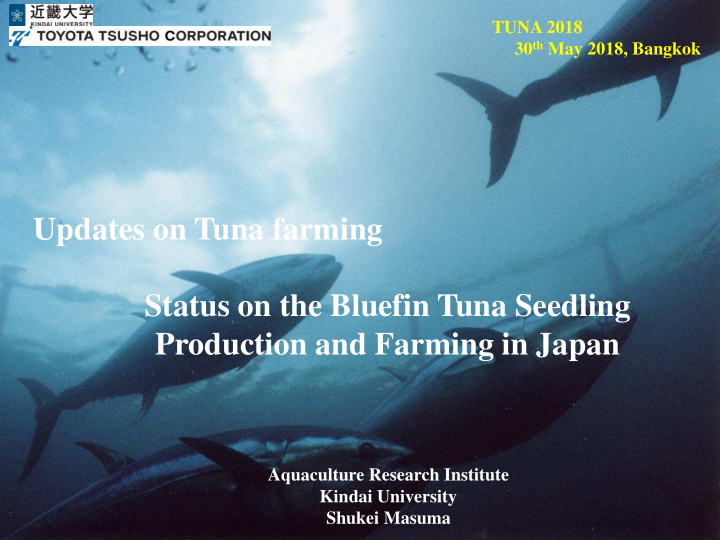



TUNA 2018 30 th May 2018, Bangkok Updates on Tuna farming Status on the Bluefin Tuna Seedling Production and Farming in Japan Aquaculture Research Institute Kindai University Shukei Masuma
Fig. Location of Pacific bluefin tuna farms in Japan ( data from Fisheries Agency of Japan : http://www.jfa.maff.go.jp/j/tuna/maguro_gyogyou/attach/pdf/bluefinkanri-5.pdf )
History of the hatchery-based aquaculture of PBFT in Japan 1970 Pacific bluefin tuna (PBFT) farming research commenced under 3-year Japanese government project for the first time in the world. 1979 Researches on PBFT seedling production started since the world’s first spawning of the captive broodstock at the Aquaculture Research Institute of Kindai University (KU). 1990 ’s Spawning in captivity and juvenile rearing in hatchery also started at private companies and governmental institute (JASFA), in addition to KU. 2002 The KU succeeded in completing the full-life-cycle of PBFT under captivity. 2004 The first-ever hatchery-based PBFT product was launched to the market by the KU. 2010’s The hatchery-based PBFT farming has been developing in Japan for “sustaining wild resources” .
Fig. Changes in production of capture-based and hatchery-based PBFT in Japan. Figures on the bars are the percentages of hatchery-based tuna farming. Notes : data on capture-based production until 2010 is estimation derived from industry journals and papers etc. Yellow bars since 2011 are plotted from a statistical data of the Fisheries Agency (FA). Data on hatchery-based production is from the Kindai until 2011 and from the FA since 2012.
Fig. Growth of PBFT larvae in hatchery with feeding regime at the KU.
Fig. Changes of number of juveniles at the time of growing about 30 cm (circa 3 months after hatching). Production of PBFT seedlings in hatchery had been conducted by one station until 2008 and after then two or three stations. All production of tuna juveniles have shifted the full-life- cycled tuna juveniles from 2016.
Fig. Spawning sites of Kindai University
Schematic diagram of PBFT full-life-cycle farming
(Ando et a l. 2007) Fig. Comparison of the concentration of total mercury in muscle of full-cycle cultured ( ■ ) and wild ( ◆ ) bluefin tunas. The samples were taken from the middle part of the dorsal muscle. The data for the wild fish are from the study of Storelli and Marcotrigiano.
Relationship between total mercury concentration in muscle and body weight of bluefin tuna in the control and experimental groups. ▲ , dorsal, front; ● , dorsal, middle; ■ , dorsal, rear; △ , ventral, front; ○ , ventral, middle; □ , feed fish (High T-Hg :0.052 ppm) ventral, rear; ◇ , tail. spotted mackerel feed fish (Low T-Hg :0.019 ppm in average) horse mackerel and Japanese sand lance (Nakao et a l. 2009)
Advantageous characteristics of artificial seedlings Contributing the sustainability of the wild tuna resources and tuna aquaculture industry Full traceability from broodstock to end-products Higher food safety. Advantages and Possibilities of artificial seedling for business Third party quality certification system has been established as “ S eedling C ouncil for S ustainable A quaculture” (Dec. 2017)
On-going: Promoting Japan-brand tuna from hatchery-based aquaculture Oversea markets as acceleration tools Other hatchery-based tuna farmers in Japan Partnership Technical supports TOYOTA TSUSHO Co. Toyota Group's Trading Company
Future goals of hatchery-based PBFT aquaculture Further development of rearing techniques to increase survival and production of seedling as well as improvement of seed qualities for reducing production cost. Control of spawning for seedling production in earlier seasons. Development of the formulated feed with less fish meal. Hatchery seedling production without relying on antibiotics etc. R&D for selective breeding for higher growth, survival, meat quality, etc.. Promoting overseas consumers about the high value of the hatchery-based farmed tuna with high sustainability and safety.
ご清聴ありがとうございました! Thank you for your attention !
Recommend
More recommend